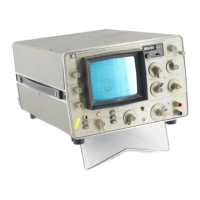Section III
GENERAL
OPERATING
INFORMATION
Model 3580A
OVERWAD indication. The
AMPLITUDE
REF LEVEL
switch
is
then set
so
that the low-level signals
of
interest can
be measured.
Signals
greater than the full-scale level
indicated by the white window on the INPUT SENSITIV-
ITY switch dial will peak the display but will not damage
the instrument or introduce harmonic or spurious
re-
sponses.
3-59. Scale Factor. The blue markings on the
AMPLI-
TUDE REF LEVEL switch dial indicate the scale factor
which, for absolute measurements
is
the factor
by
which
the INPUT SENSITIVITY
(Max.
Input) setting must be
multiplied to determine the full-scale sensitivity. For
example,
if
the INPUT SENSITIVITY switch
is
set to the
2 V range and the AMPLITUDE REF LEVEL switch
is
set
to
the X0.01 position, the full-scale sensitivity
is:
2 V X
0.01=0.02
Vor
20 mV.
3-60. For absolute measurements the full-scale sensitivity
is
conveniently indicated by the white window on the INPUT
SENSITIVITY switch
dilll
and the
scale
factor can generally
be ignored. If, for some reason, the scale factor is to be
used, note that the eveh numbered positions
on
the
AMPLITUDE REF LEVEL dial are not marked. This
is
because the scale factor in these positions depends on the
INPUT SENSITIVITY switch setting.
If
the
INPUT
SENSI-
TIVITY switch
is
set to the 20
V,
2
V,
0.2
V,
etc. position,
the unmarked positions on the
AMPLITUDE
REF LEVEL
switch
dial
represent X0.5,
XO.OS,
X0.005 and X0.0005.
If
the INPUT SENSITIVITY switch
is
set to
10
V,
1V,0.1
V,
etc., the unmarked positions represertt X0.2, X0.02,
X0.002 and X0.0002. This applies only when the amplitude
VERNIER is in the
CAL
position.
3-61. For relative measurements where the amplitude
VERNIER
is
not in the
CAL
position, the full-scale
markings on the INPUT SENSITIVITY switch dial do not
apply and, for expanded-scale measurements, a scale factor
must be used. In relative measurements the scale factor
is
the factor by which a relative amplitude reading must be
multiplied
to
obtain the correct reading in percent
of
full
scale.
3-62.
When
making relative measurements it
is
important
to remember that any time the VERNIER
is
not in the
CAL
position, the relationship between the marked and
unmarked positions
of
. the
AMPLITUDE
REF LEVEL
switch varies
as
a function
of
both the
INPUT
SENSITIV·
ITY and amplitude VERNIER settings. There
is
always a
Xl,
XO.I, X0.01,
XO.OOI
relationship between the marked
positions and this same relationship exists between the
unmarked positions. However, there
is
no longer a
XI,
X0.5,
XO.I
or
Xl,
X0.2,
X0.1
relationship between the
marked and unmarked ·positions.
To
obtain the correct
scale factor the following guidelines must be observed:
a.
If
the full-scale reference
is
set with the AMPLITUDE
REF LEVEL switch in a marked position, all measurements
must be made using marked positions.
3-10
b.
If
the full-scale reference
is
set with the
AMPLI-
TUDE REF LEVEL switch in an unmarked position,
all
measurements must be made using unmarked positions.
c. The AMPLITUDE REF LEVEL setting on which the
full-scale reference level
is
established becomes the XI
setting.
If
the XI setting
is
a marked position, the scale
factors for the remaining marked positions become XO.I,
XO.OI,
etc. Similarly,
if
the XI setting is an unmarked
position the remaining unmarked positions become XO.I,
XO.OI,
etc.
3-63. Examples. Consider the case where the fundamental
frequency component
of
an input
signal
is
0.75 V and it
is
necessary to measure the second harmonic component
whose relative amplitude
is
I%. With the AMPLITUDE
REF LEVEL control initially set to the NORMAL
(XI)
position
arid
the amplitude VERNIER fully counter-
clockwise, the INPUT SENSITIVITY switch can be set to
the 0.2 V position without overloading the instrument. The
amplitude VERNIER can then be adjusted
so
that the
amplitude
of
the fundamental frequency component
is
100%
of
full scale. The 1 % second harmonic will perhaps be
visible on the display but an expanded scale will be required
to measure it accurately. In this case, the full-scale
reference
was
established with the
AMPLITUDE
REF
LEVEL switch in the XI position. Thus, the unmarked
positions cannot be used and the scale factors
of
the
marked positions are
as
indicated on the switch dial.
By
setting the
AMPLITUDE
REF LEVEL control
to
the
XO.O
1
position, the 1 % second harmonic can be expanded to
100%
of
full scale.
It
will then be necessary to multiply the
100% reading by the X0.01 scale factor to obtain the
correct reading: 100 x 0.01 = 1
%.
3-64. Next, consider the
case
where the amplitude
of
the
fundamental frequency component
is
1.8 mV and
it
is
necessary to measure a harmonic component whose relative
amplitude
is
4%.
With the AMPLITUDE REF LEVEL
switch
in
the NORMAL
(XI)
position and the amplitude
VERNIER fully counterclockwise, the INPUT SENSITI-
VITY switch can
be
set to the 0.2 mV (lowest) range. With
a fundamental frequency component ofless than 0.2 mV, a
full-scale reference cannot be obtained on the 0.2 m V
range.
It
is, therefore, necessary to
go
to the
0.1
mV range
using the AMPLITUDE REF LEVEL switch. In this case,
the full-scale reference
will
be
established with the
AMPLI-
TUDE
REF LEVEL switch in an unmarked position. This
unmarked position becomes the
Xl
position.
To
expand
the harmonic
to
a measurable level, it will be necessary
to
rotate the AMPLITUDE REF LEVEL control clockwise to
the
n.ext
unmarked position. This unmarked position has a
scale
factor
of
XO.I
and will expand the
4%
harmonic to
40%
of
full scale.
The
correct reading can then be obtained
by multiplying the 40% reading by the
X0.1
scale factor:
40XO.I =
4%.
3-65. Alternative Method.
An
alternative method for
de-
termining the relative amplitude
of
two signals
is
to first
measure the absolute voltage levels and then calculate their
relative amplitude using the following formula:

